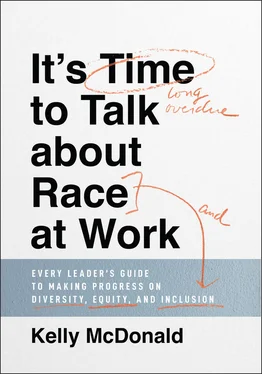I'm White. I started writing this book primarily with White readers in mind, because White businesspeople tend to assume a White perspective on things. We don't know what it's like to be “the only” in the room: the only Black person, the only Asian person, the only Hispanic person, or the only Middle Eastern person, for example. We don't know what it's like to worry about being considered for a promotion, and then if we get it, worrying about whether we are the token of diversity and that our company can now “check that off the list.” We don't know what it's like to have someone at work tell us we should go by another name so that we blend in better. (Yes, this happens. My friend Leroy is a tall, dark-skinned Black man. He sells high-end luxury cars and has a strong track record of sales. His coworker suggested he would “do better and seem less threatening” if he changed his name to Doug at work.)
White people in leadership can be oblivious. It's not intentional. It's simply the lens through which we view the world. We can't consider different perspectives if we don't hear different perspectives. And we can't hear them if we surround ourselves with people who are just like us.
My perspective on diversity, equity, and inclusion comes from more than two decades of work on this subject. I'm a professional speaker and have written three bestselling books on diversity, all from the standpoint of business . I work with all kinds of companies and all kinds of people: large Fortune 500 companies and small business owners, diversity champions and diversity skeptics. The response to my books and presentations is always positive, especially among White people, because Whites simply do not know how to talk about race and diversity. When we don't know what to do, we do nothing, and that's not good for business growth and success. Another reason that the response to my perspective on diversity has always been positive is that I don't try to change how people feel about diversity. People have very complex emotions surrounding this topic, from fear to guilt to resentment to helplessness and more. I start with one basic truth that everyone agrees with: Business is not about dealing with the world the way you want the world to be. It's about dealing with the world the way the world is . Framed in this way, the topic of diversity is more palatable to most people. I'm not trying to change hearts and minds. I'm trying to change business .
Make no mistake: I believe that only good things come from a more diverse workplace, and I cover all of those in Chapter 4. And I believe that we benefit as a society and as people if we make progress on diversity, equity, and inclusion. But this book is focused on the skills you need to talk about a key issue that affects business .
You're focused on this issue, too. You're on the first chapter of a book that will show you how you can help— actually, truly, measurably, and meaningfully help . You're a businessperson. The way that you can help is through your company, team, and customers. You can help create a fair, equitable, and inclusive workplace for everyone, and by doing that, you can literally help change the world.
Right now, you could be doing any number of fun things: playing with your kids, talking with a friend, making a meal, watching your favorite TV show, working out, researching your next vacation, eating ice cream! But you're not. You're reading a book on how to talk about race and diversity at work and hoping you'll get some insights and tips for making your workplace or teams better . Better for all . You are investing your time right now in learning how to talk about and address a topic that is important and uncomfortable .
For a while, it felt as if we were lulled into thinking we, as a society, had made some progress! After all, the U.S. had a Black president for eight years, so how bad could racism still be?
On May 25, 2020, we found out exactly how bad it could be. On that date, George Floyd died on a street in Minneapolis, pinned to the ground, as four police officers sat on him and one knelt on his carotid artery. It took eight minutes and forty-six seconds for George Floyd to die. Later, we learned this was actually even longer than we thought: Nine minutes and twenty-nine seconds. And we watched it happen .
Suddenly, the problem of racism was no longer abstract. The terrible, awful, chilling, stomach-turning death of George Floyd made us— and especially White people —realize that, despite whatever progress we think we've made, the world is not equal for everyone. Many of us responded the only way we knew how: by saying, “Enough is enough” and “Things MUST change.”
It was an historic moment. Millions of people took to the streets to march for racial equality. Thousands of companies and businesses took a hard look at their own organizations and asked, “How can we do better?” It didn't just happen in the United States; millions of people in all parts of the world marched for weeks, demanding justice and change. It happened in cities. It happened in small, rural towns where almost everyone is White. Old and young, of every color, every race, everywhere , said, “We have to do something. Now .” But what? What do we do?
THIS BOOK IS A STARTING POINT TO A MORE INCLUSIVE WORKPLACE
It's OK to be uncertain about what to do. You want to make a difference, but at some companies, the emphasis on diversity, equity, and inclusion has been heavy-handed. It feels like “marching orders” instead of being part of positive change. Perhaps you feel skeptical or mistrustful about diversity efforts, like you're standing on shifting ground, because at any moment, you could say the wrong thing and someone will yell, “Gotcha!”. If you're White, you may feel like anything you do may be “wrong,” misinterpreted, or misunderstood and backfire or blow up in your face. You may be nervous and conflicted because you genuinely and sincerely want to help and make a difference, but you don't know the way forward. And you're uncomfortable.
Whether you're White, Black, Indigenous, or a person of color, male or female, non-binary or trans, gay or straight, old or young, left-leaning or right-leaning, a leader or business owner or employee, this book can be helpful to you. You will learn what to do—and what not to do—to have constructive conversations about race, not from an activism standpoint, but from a business standpoint. In Chapter 10, you'll learn the STARTING Method, an eight-step framework that will show you, step-by-step, how to become a more diverse and inclusive company, department, or team.
But to begin our journey, let's start with who you, the reader, are and what this book is—and isn't.
Readers who will benefit the most from reading this book will fall into a few specific categories:
The CEO, president, business owner, or business leader who recognizes that their company or enterprise is not very diverse and that this is a real business problem that negatively affects the organization's performance, growth, and profit.
The executive who has been tasked by their organization to lead, create, expand, or improve their DE&I (diversity, equity, and inclusion) efforts internally.
The team leader who does not have a diverse team and wants to change that in a relevant way, bringing new talent, skills, and perspective that avoids tokenism.
The team leader who does have a diverse team, but recognizes that some members of the team may not feel included or heard or perhaps have not received the same chances and opportunities for professional development and advancement as others have.
Читать дальше












